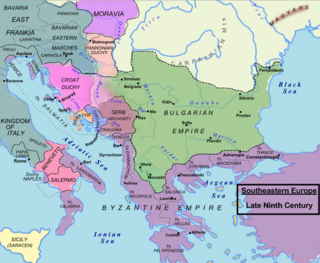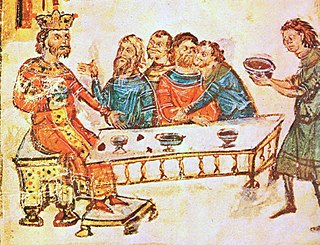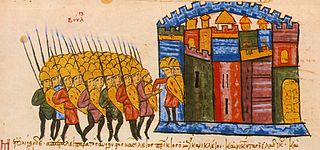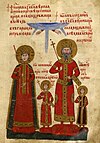
When the Roman Empire divided into east and west in 395, the territories of modern Albania became a part of the Byzantine Empire. At the end of the 12th century, the Principality of Arbanon was formed which lasted until mid 13th century, after its dissolution it was followed with the creation of the Albanian Kingdom after an alliance between the Albanian noblemen and Angevin dynasty. After a war against the Byzantine empire led the kingdom occasionally decrease in size until the Angevins eventually lost their rule in Albania and led the territory ruled by several different Albanian chieftains until the mid 14th century which for a short period of time were conquered by the short-lived empire of Serbia. After its fall in 1355 several chieftains regained their rule and significantly expanded until the arrival of the Ottomans after the Battle of Savra.

Silistra is a town in Northeastern Bulgaria. The town lies on the southern bank of the lower Danube river, and is also the part of the Romanian border where it stops following the Danube. Silistra is the administrative center of the Silistra Province and one of the important towns of the historical region of Southern Dobrudzha.

The Battle of Southern Buh occurred near the banks of the eponymous river. The result was a great Bulgarian victory which forced the Magyars of the Etelköz realm to abandon the steppes of southern Ukraine, as well as their aspirations of subduing Danube Bulgaria, retreating to the newly occupied lands beyond the Carpathian Mountains, centering on Pannonia, from where they will stage their next war, against Moravians this time, defeating them and establishing a new Hungary, after the Etelköz state in modern Ukraine, which succeeded an earlier stage of statehood for the Magyars, the legendary although short-lived Levedia, and even one before that, in the actual country of origin for the Magyars, Yugra, beyond river Ob.

Shishman, also Shishmanids or Shishmanovtsi, was a medieval Bulgarian royal dynasty of Cuman origin.

The Battle of Spercheios took place in 997 AD, on the shores of the Spercheios river near the city of Lamia in central Greece. It was fought between a Bulgarian army led by Tsar Samuil, which in the previous year had penetrated south into Greece, and a Byzantine army under the command of general Nikephoros Ouranos. The Byzantine victory virtually destroyed the Bulgarian army, and ended its raids in the southern Balkans and Greece. The major historical source on the battle comes from Greek historian John Skylitzes whose Synopsis of Histories contains a biography of the then-reigning Byzantine Emperor, Basil II.

The Bulgarian-Serbian wars were a series of conflicts between the Bulgarian Empire and medieval Serbian states between the 9th and 14th centuries in the central Balkans.

The medieval Bulgarian army was the primary military body of the First and the Second Bulgarian Empires, and some Puppet states of the former, like the Despotate of Dobruja. During the first decades after the foundation of the country, the army consisted of a Bulgar cavalry and a Slavic infantry. The core of the Bulgarian army was the heavy cavalry, which consisted of ca. 12,000 heavily armed riders. At its height in the 9th and 10th centuries, it was one of the most formidable military forces in Europe and was feared by its enemies. There are several documented cases of Byzantine commanders abandoning an invasion because of a reluctance to confront the Bulgarian army on its home territory.
The siege of Varna took place between 21 and 24 March 1201 at Varna, on the Bulgarian Black Sea coast between the Bulgarians and the Byzantines. The Bulgarians were victorious and captured the city.

Irene Komnene Doukaina or Eirene Komnene Doukaina was an Empress of Bulgaria during the Second Bulgarian Empire and Byzantine princess. She was the third wife of tsar Ivan Asen II of Bulgaria. She was the mother of tsar Michael Asen I of Bulgaria.

The Treaty of 716 was an agreement between Bulgaria and the Byzantine Empire. It was signed by the son of the ruling Bulgarian Khan Tervel, Kormesiy and the Byzantine Emperor Theodosios III.
The Treaty of 815 was a 30-year peace agreement signed in Constantinople between the Bulgarian Khan Omurtag and the Byzantine Emperor Leo V the Armenian.

Kutmichevitsa was an administrative region of the Bulgarian Empire during 9th-11th cent., corresponding roughly with the northwestern part of the region of Macedonia and the southern part of Albania, broadly taken to be the area included in the triangle Saloniki-Skopje-Vlora. It had an important impact on the formation, endorsement and development of the Old Church Slavonic and culture. The Debar–Velich diocese of the Bulgarian Orthodox Church was created in Kutmichevitsa whose first bishop between 886 and 893 was Clement of Ohrid, appointed by Knyaz Boris I.
Isbul was the kavhan, or first minister, of the First Bulgarian Empire during the reigns of Omurtag, Malamir and Presian I. Appointed to the kavhan office under Omurtag, Isbul was a regent or co-ruler of the underage Malamir and his successor Presian.
The siege of Sofia took place in 1382 or 1385 during the course of the Bulgarian–Ottoman wars. Unable to defend his country from the Ottomans, in 1373 the Bulgarian emperor Ivan Shishman agreed to become an Ottoman vassal and to marry his sister Kera Tamara to their sultan Murad I, while the Ottomans were to return some conquered fortresses. Despite the peace, in the beginning of the 1380s the Ottomans resumed their campaigns and besieged the important city of Sofia which controlled major communication routes to Serbia and Macedonia. There are little records about the siege. After the futile attempts to storm the city, the Ottoman commander Lala Shahin Pasha considered to abandon the siege. However, a Bulgarian renegate managed to lure the city governor ban Yanuka out of the fortress to hunt and the Turks captured him. Leaderless, the Bulgarians surrendered. The city walls were destroyed and an Ottoman garrison was installed. With the way to the north-west cleared, the Ottomans pressed further and captured Pirot and Niš in 1386, thus wedging between Bulgaria and Serbia.

The Bulgarian-Serbian War of 839–842 was fought between the First Bulgarian Empire and the Serbian Principality. It was the first conflict of the medieval Bulgarian–Serbian Wars.
Leontius was the first Patriarch of the Bulgarian Orthodox Church. Very little is known of his life and tenure. He was mentioned as the first Patriarch of Bulgaria in the Book of Boril, written in 1211.
Vissarion was a Patriarch of the Bulgarian Orthodox Church in the 13th century. He is the only Bulgarian Patriarch who was not included in the list of Patriarchs in the medieval Book of Boril. The only testimony of his existence is an undated seal reading "Vissarion, by the grace of God Patriarch of the Bulgarians". It is suggested that he presided over the Bulgarian Church during the rule of emperor Ivan Asen II and was omitted in the lists because he supported the union with the Catholic Church concluded by emperor Kaloyan and abolished by Ivan Asen II.
Joachim III was the Patriarch of the Bulgarian Orthodox Church between c. 1282 and 1300, when the Second Bulgarian Empire reached its lowest point of decline during the reign of the emperors George Terter I, Smilets and Chaka. He was executed for treason by emperor Theodore Svetoslav in 1300. The Church did not recognize his guilt and his name was included in the list of Bulgarian Patriarchs in the Book of Boril. His seat was Tarnovo, the capital of Bulgaria.
Joachim I was the Patriarch of the Bulgarian Orthodox Church between 1235 and 1246. He was the first head of the restored Bulgarian Patriarchate with seat in Tarnovo, the capital of the Second Bulgarian Empire. Joachim I died of natural death on 18 January 1246 and was proclaimed a saint. He was the founder of an extensive monastic complex known as the Rock-hewn Churches of Ivanovo, now included in the UNESCO World Heritage List.

















